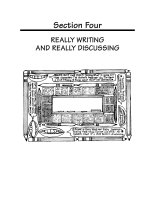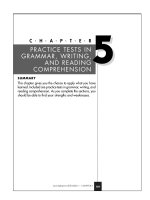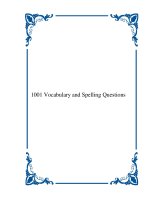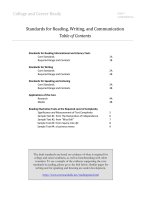Oxford discover 4 writing and spelling
Bạn đang xem bản rút gọn của tài liệu. Xem và tải ngay bản đầy đủ của tài liệu tại đây (9.94 MB, 65 trang )
OXFORD
UNIVERSITY
PRESS
Scope and Sequence
Writing
WORDS TO
KNOW
How cơn we
ee eee
past?
Cora
Ue
La)
camo beat)
your food
travel?
PLANNING
TOOLS
WRITING
FOCUS
WRITING
OUTPUT
camper explore universe
technology attached director
solar system observatory
telescope mission control
spacecraft antigravity
Formal and informal
Awelcome letter
Word web
fossil preserve palaeontologist
dinosaur footprint determine
Topic sentence and
concluding sentence.
text
An informational
KWL chart
organic fresh process local
grocery store compare lemon
Summarizing with a bar
Abar graph
graffiti improve famous
Supporting an opinion
with reasons
An opinion text
T-chart
Adescriptive text
Word web
Cause and effect
Aprocess text
Cause and effect
Writing within a restricted
word count
Anews web post
deep crack earthquake
crumble collapse landslide
gloomy flood muddy swoop
mucky tornado
Descriptive adjectives and
onomatopoeia
An adventure story
Planning chart
proposal
Persuasive writing
A proposal
Chart
discover examine
scientist prehistoric
pear strawberry
shark
language
reptile
mushroom
graph
Bar graph
Page 16
talented beautiful illegal legal
spray paint paintbrush
ruin complex
canvas
congested ramen noodle
slippery crispy spicy cherry
fresh peaceful sushi tuna
squishy
How do our
bodies react to
emotions?
Page 34
react heartrate blood
pressure
increase
pupil
muscles tense immune system
digestive system
investigate
pump
app
crime
importan†?
Page 52
happen
website
propose
destruction
educate
terrible
artificial
rainforest biome humid
difference
tight
Internet post
suspect social network
Why are
artificial biomes
dilate
experience
Main idea and
details chart
1
Page 58
Words with silent letters:
wrong, rhyme, knee
Words with ch and que:
archaeologist, antique
Page 58
3
Page 59
4
Page 59
Prefix dis-:
dishonest, dissatisfied
5
Words with cand sc:
6
-ate and -ete endings:
PETA}
Page 60
Page 61
Ễ
introduce, science
:
circulate, delete
Mnemonics
slowly, greedily
Page62
-ent, -ence, -ant, and -ance endings
9)
<
m
5=
SPELLING FOCUS
¬
Spelling Master Class
FOCUS:
Formal vs. informal language
OUTPUT:
A welcome letter
How can we learn about
the universe?
Words to know
camper
explore
director
universe
solar system
mission control
technology
observatory
spacecraft
attached
telescope
antigravity
Read
LA)
@
A welcome letter greets people and gives information about a place.
When would you get a welcome letter? Check.
At soccer camp
At anew job
At a house
At a hotel
With a computer
At a school
Read the welcome letter.
explore the solar
system
Dear Space Campers,
Observatory
Welcome to your summer space camp
and telescope
workshop
adventure! You are going to have a great
time exploring space with us. You will
learn about our universe in classes and by
using technology.
Ạ
DN
9
— |
explore the mission
control room
—
4
Unit 1
How can we learn about the universe?
Please see the attached calendar for a list
of activities.
mà a spacecraft
Expl
and an antigravity
Thank you for joining our program. We can’t
wait to see you in space!
room
4
—
Sincerely,
Doris Connelly
Space
communication
Camp Director
Understand
@
Match the sections of the letter to the information.
1 ()
2 C)
Greeting
Paragraph 1
4 C)
Paragraph 3
5 C) Closing
a describes the calendar of activities or refers to an attached calendar
b ends the letter and gives the name of the writer
c addresses the reader and gives some description about the program
d tells who the letter is for
e thanks the reader for being a part of the program
oO
Look at the photo in ©. Which activity does it show?
How can we learn about the universe?
Unit 1
5
@
Look at the space camp calendar of activities in ©.
Then read what Eva did. Write the correct day.
Q@e learned how
people sent laser
communications to
the moon.
Qe learned a lot of
Qe went up high in this
My parents came today,
and ( showed them all
of the things ( did
building, and we looked
at stars. {t was really
cooff
(was in a room with a
lot of computers. We
learned how people
on Earth work with
astronauts on space
missions.
@
e
6
interesting things about
all of the planets and
the sun.
daring the week.
( put on a special suit
and went into a room.
There wasnt any
gravity in the room, and |
(floated around, fast
like in space!
Look at the calendar again. Which activities would you like
to do? Why?
Awelcome letter uses “you” to give the reader information.
Why do you think it does this?
Unit1
Think
Oo
Think of ideas for a summer camp for children. Write as many
ideas as you can.
Description
Camp
(
Activities
——y
How can we learn about the universe?
Unit 1
7
Organize and Plan
©
writing focus
When we write a welcome letter, we use formal language.
Formal
Informal
Does not use contractions
Uses contractions
You are going to have
a great time.
You’re going to have
a great time.
Does not use abbreviations
Monday
Uses abbreviations
Mon.
Uses formal words and greetings
Uses informal words and greetings
Dear Space Campers,
Hey Mom and Dad,
Look at the letter and calendar in ©. Write the formal words.
T1 WơtlllEfidbØúfBúENEISE:a
2 Thanks for joining our pogram.
3
8
__.
Bye,
4 Wed.
@
y
———————
—
ee
—
Look at your description in (). Describe your camp using formal words.
Unit 1) = How can we learn about the universe?
Write
@
Now write your welcome letter and a calendar for your camp.
Use your work in activities ) - to help you.
Greeting
Welcome
Refer to calendar
Thank the reader
Closing
Monday
Tuesday
Wednesday
Thursday
Friday
Saturday
|
Ị
Edit
oO
Read and check. Now read your partner's writing and check
if you agree.
In my welcome letter:
af
L]
CI
I can write a formal greeting and a formal closing.
L]
L]
T1 can use formal language.
L]
Ican write complete sentences.
ae
How can we learn about the universe?
Unit 1
q
FOCUS: Topic sentence and concluding sentence
OUTPUT:
An informational text
How can we learn from the past?
Words to know.
fossil
preserve
discover
palaeontologist
examine
shark
dinosaur
scientist
footprint
prehistoric
determine
reptile
Read
©
@
An informational text gives readers real information about something.
What types of informational texts have you read?
Read the informational text.
Learning from Fossils
A fossil is a part ofa plant or animal that
has been preserved
in the Earth. Fossils,
like bones, teeth, and footprints, help
people learn important things about
the past.
Palaeontologists learned a lot about
dinosaurs from their fossilized footprints.
They determined whether some
dinosaurs walked on two or four legs,
and if a dinosaur traveled in groups
or alone, by looking at the number
of footprints. They learned that many
dinosaurs walked with their tails in the
air, because the footprints
did not have
any “drag marks” near them.
10
Unit2
Howcanwelearn from the past?
By looking
at how far apart some footprints were,
palaeontologists discovered the fastest dinosaurs
could run over 40 kilometers per hour.
By examining fossilized sharls teeth,
scientists determined that sharks
lived over 400 million years ago,
before the dinosaurs. They learned
that one prehistoric shark, called
Squalicorax, had teeth with edges
like a knife. Scientists discovered
that the Squalicorax
ate large fish
and reptiles, because they found
fossilized bones of these animals
with Squalicorax teeth in them!
People will continue to learn even
more about the past from fossils.
Understand
@
What is the main idea of the text? Circle.
a Fossils are found in many parts of the world.
b People learn about the past from fossils.
¢ People learn the most from dinosaur and shark fossils.
d People learn about the future from fossils.
oO
According to the text, what have people learned from fossils? Check.
1
some dinosaurs traveled in groups
2
most dinosaurs walked with their tails on the ground
3
some dinosaurs could run fast
4
dinosaurs are older than sharks
5
sharks could swim fast
6
sharks ate large fish and reptiles
How can we learn from the past?
Unit2
T1
@
Look at the last sentence of the text. What does it do? Check.
summarizes the information in the text
makes a prediction about what will happen in the future
gives the writer’s opinion
@
Look at the photo of fossilized dinosaur footprints. What can you
guess about the dinosaurs by looking at the footprints?
e
If you found a fossilized shark tooth, what would you do with it?
12
Unit2
Howcar
Think
©
What other things can we use to learn about the past?
Write as many ideas as you can.
k
f
ani
that
4
sundials that tell time
==
live
tod
SE
ancient pottery
ancient jewelry
đồ
Choose one of the things in (") to write about in an informational text.
What do you know about this object? What do you want to know? Write.
Thing from the past:
K What I know
@)
W What I want to know
L What I learned
Use books, magazines, or the Internet to find out about your object
from the past. You can also ask someone in your family. Write what
you have learned in the“L” column in the chart in).
How can we learn from the past?
Unit2
13
Organize and Plan
Q
Writing focus
A topic sentence gives the main idea of a text. It is near the beginning.
Fossils, like bones, teeth, and footprints, help people learn important things
about the past.
A concluding sentence can summarize a text, give an opinion, or make a
prediction. It is near the end.
Summary: People learn many important things about the past from fossils.
Opinion: I think everyone should read about fossils and what they tell us
about the past.
Prediction: People will continue to learn even more about the past from fossils.
Look at the text in (). What kind of concluding sentence did the
writer use?
Look at your ideas in (). Write a topic sentence and three kinds
of concluding sentences for your informational text.
Topic sentence:
Concluding sentences
Summary:
Opinion:
Prediction:
Now circle your best concluding sentence.
Look your ideas in ()). Choose the six most interesting facts
and write them in a logical order.
14
Unit 2
How can we learn from the past?
Write
@
Now write your informational text to explain what can be learned
from the past. Use your work in activities ({) - () to help you.
Title
Ts
<
Topic sentence
Facts
Concluding
sentence
Edit
Oo
Read and check. Now read your partner's writing and check
if you agree.
In my informational text:
L]
L]
~
1 can write q †opic sentence and a concluding senlence.
LI
Ican write facts about my object from the past.
w
wcanwelearn from the past?
Unit2
15
FOCUS:
Summarizing witha bar graph
OUTPUT:
A bar graph
How far does your food travel?
Words
organic
compare
to know.
fresh
process
lemon
pear
local
strawberry
grocery store
mushroom
Read
©
A bar graph shows data organized in a diagram. Look at the
bar graph on page 17. What two things does it compare?
@
Read the text.
FOOD
TRAVELS
~
Eating local food is better than eating food that comes from far
away.The shorter the travel, the fresher the food is. Organic
beans that come from far away are healthier than a can of
processed beans, but local beans from a farmer’s market are
the best option! However, eating local foods can be expensive,
so you have to make the best choices for yourself.
16
Unit3
How fardoesy
t food travel?
So, how far does
our food travel?
We compared
the foods from
a local farmer's
market anda local
grocery store.
How Far Food Travels
100
q0
80
70
60
50
40
30
20
10
(Farmer's Market
â
o
Grocery Store
ô
`
â
v
w
et
@
â
Ss
&&
&
@
Ss
`4
sOo
rad
`
Oo
Undersand
Q
Write the numbers.
How far do ... travel?
1 Lemons
Farmer’s Market
Grocery Store
15 km
2 Pears
3 Strawberries
——
4 Carrots
5 Mushrooms
6 Beans
oO
Read the text in ©). Put the sentences in order from best (1) to worst (3).
Buy organic tomatoes from Chile at a grocery store.
Buy a can of tomatoes that comes from Italy.
Buy tomatoes from a local farmer's market.
How far does your food travel?
Unit3
17
@
Now read some information about other fruits and vegetables.
Then read the bar graph. Label the bar graph with the correct
fruit or vegetable.
Apples and onions travel five kilometers from the farm to the farmer's
market. Oranges travel 10 km, and potatoes travel 15 km.
Distance in km
Apples travel 20 km to get to the grocery store. Onions travel 35 km,
oranges travel 70 km, and potatoes travel 45 km.
Farmer's Market
@
18
Food
@&
Grocery Store
Why do you think it’s better to buy local food? What might be
bad about buying local food?
Unit3
How fardoes your food travel?
Think
e
What fruits and vegetables do you and your family eat? Make a list.
Hi) Look at the chart. Find six of the foods you wrote in ©. Circle.
Food
Travel to grocery
store in km
Travel to farmer’s
market in km
5
20
20
55
Beans
5
us
Carrots
10
20
15
70
5
25
Lemons
15
95
Mangos
25
85
Mushrooms
5
50
Onions
5.
35
Oranges
10
70
Peaches
10
65
5
HO
Potatoes
15
45
Strawberries
10
60
Tomatoes
5
30
Apples
Avocado
Cucumber
Grapes
Pears
How far does your foodtravel?
Unit3
19
Organize and Plan
Writing focus
Bar graphs help to summarize information. A bar graph has these parts:
Title Key words that explain what the graph is about
Labels Words on the side and the bottom that explain the information
ina graph
Scale Numbers that show the units of measurement
© Bars These measure the information
Key Words that show what the bar colors represent
Look at the bar graph. Write the names of the parts.
ee
2,
How Far Food Travels
i Farmer's Market
™& Grocery Store
Beans
@
Mushrooms
Se
Carrots
Strawberries
Pears
Food
Lemons
Use the foods you circled in ©) for your bar graph.
Write information for your graph in the spaces below.
Title
Labels
Scole
Key
20
and
0kmto.................... (highestnumber for food you circled in @))
and
Unit3 = How far does your food travel?
Write
@
Now make your bar graph. Use your work in @- ©) to help you.
70
65
60
E| 4s
55
| 40
| 35
| 30
25)
20
15
ơ
10
Edit
@
Read and check. Now read your partner's writing and check
if you agree.
In my bar graph:
L]
Ican write a title that describes my graph.
L]
L]
I can write labels and make a key for my graph.
L]
L]
I can fill in bars for my graph.
x
How far does your food travel?
Unit3
21
FOCUS:
4
Supporting an opinion with reasons
OUTPUT:
makes something art?
Words to know.
graffiti
legal
improve
spray paint
famous
talented
paintbrush
canvas
beautiful
ruin
illegal
complex
Read
@
An opinion text gives the writer's point of view about a topic.
What strong opinions do you have?
@
Reod the opinion †ex†s below.
Tonya Summers
ea
=
oH
a
=
3
ey
zed
=
Ba
H33
22
In my opinion, graffiti is art. One reason
is because graffiti often improves a
building. Some buildings are very ugly,
but graffiti makes them look better.
Another reason is that many people
have become famous for their graffiti.
Some graffiti artists are very talented
people who paint beautiful pictures. The
final reason is that people appreciate
looking at graffiti, and art is something
for people to enjoy. | don’t think people
should put graffiti on buildings illegally,
but there are a lot of legal places for
graffiti, like graffiti parks. For these
reasons, graffiti is definitely art!
Unit
= What makes something art?
An opinion text
a
Dan Jones
a
Eủ
a
g
H
&
gE
EB
#]
#
=
| don’t think graffiti is art. First of all, it
is illegal. People use spray paint instead
of paintbrushes, and they use buildings
like they are canvases. Secondly, graffiti
should not be called art because it
is often ugly. Graffiti ruins buildings.
Finally, graffiti shouldn’t be called art
because you don’t need talent to do it.
You don't have to be a real painter or
paint complex pictures to make graffiti.
For these reasons, | believe graffiti is
Đ
not art.
Understand
â
Answer the questions.
1. Who thinks graffiti is art?
2 Who doesn't think graffiti is art?
©
Are these statements facts (F) or opinions (O)? Write F or O.
1 ____ Graffiti is art.
2
__
3
__.... Graffiti can be illegal.
‡ _
5
6
@
Graffiti isn’t art.
There are graffiti parks where people can make graffiti.
____ Some people have become famous for their graffiti.
___. Graffiti is ugly.
Do you think graffiti should be legal or illegal? Explain your opinion.
What makes something art?
Unit4
23
@
Read the opinions below. Write (A) if the opinion supports graffiti
and (B) if the opinion does not support graffiti.
1
Graffiti makes ugly buildings look better.
2 ___
Graffiti is ugly.
3
_ Anyone can be a graffiti artist.
t‡ _
People who make graffiti are real artists.
5
People like to look at graffiti.
6 ___. Making graffiti is illegal.
@
Look at the graffiti. What do you like about it? What dont you like?
â
Why do you think people make graffiti?
24 =
Unit&
Đ=What makes something art?









